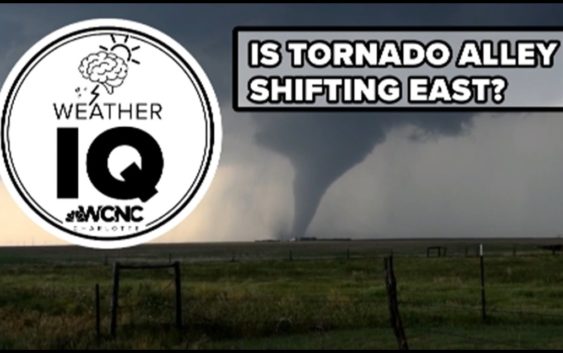- Wildfires persist across Carolinas amid windy, dry conditions
- York County crews help battle South Carolina wildfires
- Crews battle wildfires in North and South Carolina amid dry conditions and gusty winds
- As wildfires grip South Carolina, governor warns: Burn and you’ll go to jail
- Sebastian Aho's OT goal lifts Hurricanes past Flames 2-1
Weather IQ: Is Tornado Alley Shifting East?

Most of us know Tornado Alley as being the most active place for large and dangerous tornadoes in the Central United States, but that could be changing.
CHARLOTTE, N.C. — The United States averages over 1200 tornadoes every year. Many of those reported here, tornado Alley. But this zone may be bigger think.
Is Tornado Alley Expanding or Shifting East?
Tornadoes can happen anytime of year but their frequency increases dramatically during April, May and June. From Texas to South Dakota, this zone known as Tornado Alley is infamous for numerous large long track tornadoes. However, the number of tornadoes has increased further east forming a new Tornado Alley, which covers a much bigger area.
The United States receives more tornadoes than any other country due to its weather set up. Warm moist air from the gulf collides with cold air from the northwest and warm dry air from the west. This is the prime set up for widespread severe weather outbreaks.
But this pattern is trending further away from the original tornado alley.
The Reason Why:
More evidence is needed to say empirically why this shift is happening, but our local National Weather Service did say the increase in radar technology and social media have led to more reported tornadoes as well.
“Now that we are in this new social media driven world, another 10 years of research and data will help us, more accurately decipher why this trend is happening,” tells Trisha Palmer from the National Weather Service Office in Greenville-Spartanburg.
However, the recent change could be due to changes to the climate. Widespread droughts to the west and southwest, which has appeared to shift this pattern further east. The Plains are also drier than they once were, which is limiting the amount of historic tornadoes seen in the past.
Check out this map.
Since 1979, the amount of favorable tornado days, has declined for Texas and part of the Original Tornado Alley. Meanwhile the number of tornado days has shot up east of the Mississippi River.
The ingredients needed to produced long lived epic tornadoes is flourishing more and more here in the area of red (see graphic above), around Arkansas, Mississippi, Alabama and Tennessee. This is the second official tornado alley known as Dixie Alley.
This area is responsible for most of the tornado fatalities since 1950, mainly due to higher population compared to the central U.S. (This area also has more nocturnal tornadoes on record).
There are Multiple Tornado Alleys:
The Tornado Alley in the Central United States gets all of the recognition and Dixie Alley is up and coming. These two are recognized by the National Weather Service and the Storm Prediction Center. However, there are two more.
These two are unofficial but have been discussed by both organizations mentioned above. Hoosier Alley around Indiana is ranked as the third most active tornado alley according to the research from Michael Frates. Lastly a smaller 4th called Carolina Alley (located right in the sandhills and the coastal plain) was also recognized.
As we head into Tornado and Severe Weather Season, the National Weather Service asks if you see a tornado or any damage, to report it to them.